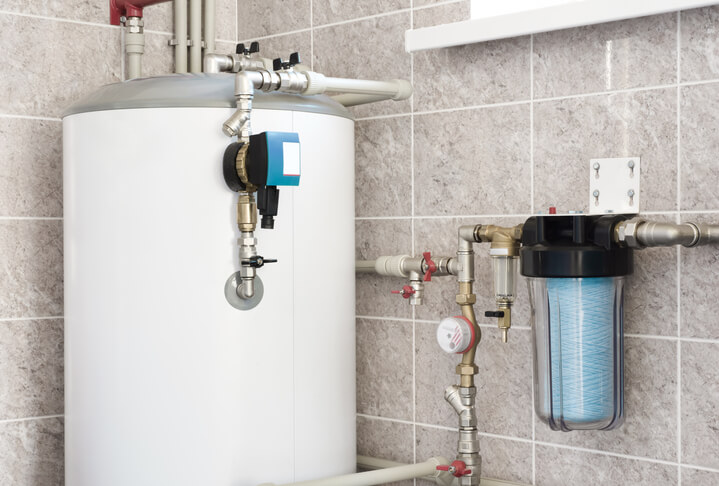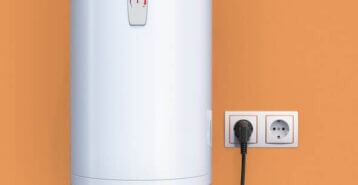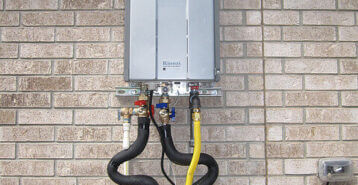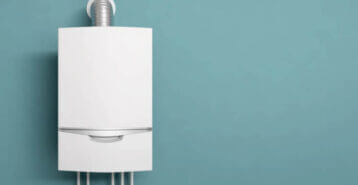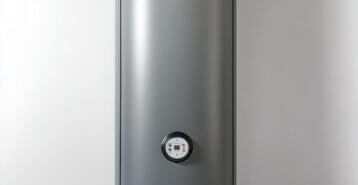A water heater is just a water heater. Right? Not exactly. Water heaters should be sized to suit your home and overall water usage. That means that a water heater tank that holds 30 gallons might be great for a small apartment but will be woefully inadequate for a home with five bedrooms.
But what if you don’t have a tank at all? Tankless water heaters warm up the water on demand, but the flow rate then becomes an issue. Understanding what size of water heater you need can help prevent frustration and a lack of hot water when you need it.
Here’s what you need to know about water heater sizes and how much each will cost.
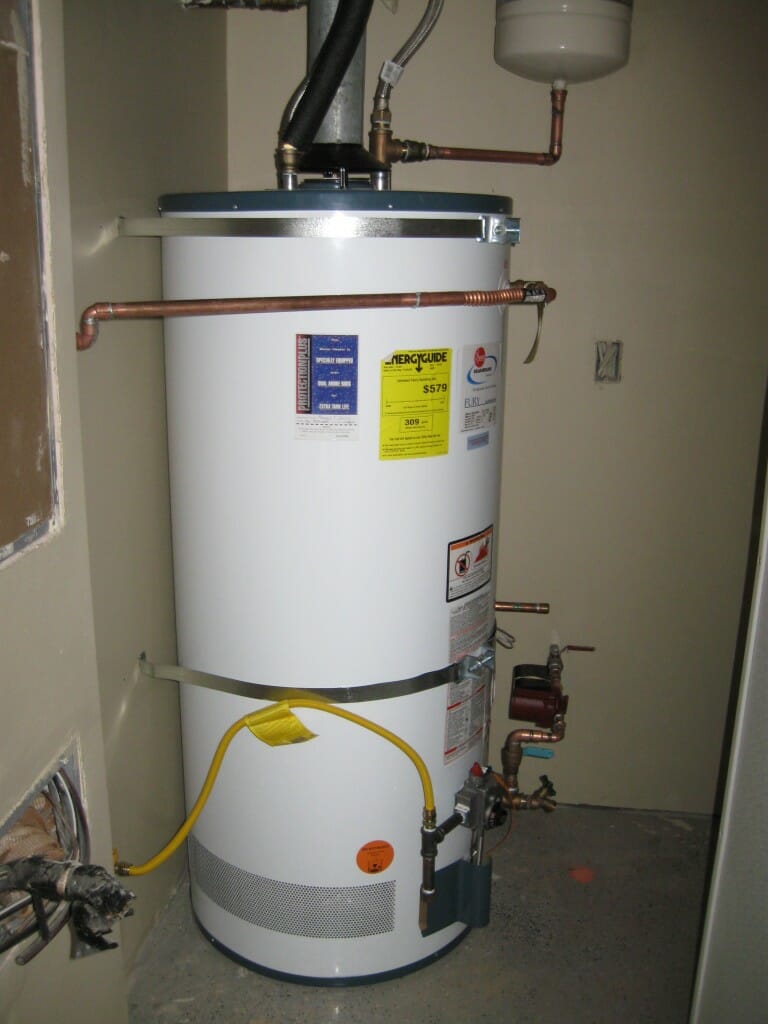
Types of Water Heaters
There are two main types of water heaters: those with a tank and those without. Those with a tank are the traditional water heaters you might be accustomed to seeing, while the tankless water heaters are just what they sound like — they have no tank. Instead, the water flows through pipes and heats on demand.
Tank Water Heaters
The conventional storage water heater typically holds between 30 and 80 gallons. The water heater uses whatever fuel your household prescribes to – liquid propane, oil, electricity, solar, or natural gas — to keep the water in the tank at a constant temperature that you set with the attached thermostat. When you turn on the hot water anywhere in the house, the heated water flows from the tank to the faucet or appliance.
-
Pros
- Affordable Repair Work
- Lower Installation Costs
- Less Maintenance Required
- Lower Up-Front Cost
-
Cons
- Water Always Heated
- Space
- 10-15 Year Lifespan
Pros
- Affordable Repair Work: Repairing a tank water heater is generally more affordable than fixing a tankless model. This is because the technology used in tank water heaters is simpler and parts are more readily available, resulting in lower labor and material costs.
- Lower Installation Costs: Installing a tank water heater typically costs less than installing a tankless water heater. This is due to the straightforward installation process of tank models, which often involves less labor and fewer modifications to your home’s plumbing and electrical systems.
- Less Maintenance Required: Tank water heaters require less maintenance compared to their tankless counterparts. Routine tasks such as flushing the tank and inspecting the anode rod are relatively simple and infrequent, making upkeep easier and less costly over time.
- Lower Up-Front Cost: The initial purchase price of a tank water heater is generally lower than that of a tankless water heater. This makes tank water heaters a more budget-friendly option for homeowners who need to replace their water heater quickly or who are working within a limited budget.
Cons
- Water Always Heated: Tank water heaters continuously heat water to maintain the set temperature, even when it is not being used. This can lead to higher energy bills as energy is wasted keeping the stored water hot throughout the day and night.
- Space: Tank water heaters require a considerable amount of space for installation, as they need room to house the tank itself. This can be a disadvantage in homes with limited space, such as apartments or small houses, where every square foot counts.
- 10-15 Year Lifespan: The average lifespan of a tank water heater is only 10-15 years. This means homeowners may need to replace their tank water heater more frequently compared to tankless models, which can last 20 years or more. The shorter lifespan can result in higher long-term costs due to more frequent replacements.
Tankless Water Heaters
Tankless water heaters provide water on demand. Instead of water sitting in a tank and staying hot until you’re ready to use it, the water flows through pipes and is heated on its way to the faucet. However, the trade-off is a lower flow rate, because the heating mechanisms can only heat small volumes of water as it flows.
The result is that you can’t use two appliances at once, or take a shower while you’re running the washer. However, many homeowners get around that by installing more than one tankless water heater; sometimes they install one water heater per appliance!
-
Pros
- Heats Water on Demand
- Saves Space
- Long Lifespan
- Unlimited Hot Water
-
Cons
- Higher Upfront Costs
- Limited Capacity
- Inconsistent Temperature
Pros
- Heats Water on Demand: Tankless water heaters provide hot water on demand, heating it only when you turn on the tap. This efficiency means you’re not paying to keep a tank of water hot all the time, which can significantly reduce energy bills.
- Saves Space: Tankless water heaters are compact and can be mounted on a wall, freeing up valuable floor space. This makes them an ideal choice for smaller homes or apartments where space is at a premium.
- Long Lifespan: With regular maintenance, tankless water heaters can have a lifespan of 20 years or more. This longevity means you won’t need to replace your water heater as frequently as you might with a traditional tank model, resulting in long-term savings.
- Unlimited Hot Water: Tankless water heaters provide a continuous supply of hot water, so you won’t run out during a long shower or when multiple appliances are in use, provided the unit is correctly sized for your household’s needs.
Cons
- Higher Upfront Costs: The initial purchase and installation costs of tankless water heaters are higher than those of traditional tank models. This can be a significant investment, though it may be offset over time by energy savings.
- Limited Capacity: Tankless water heaters are sized based on typical household usage. An unexpected increase in demand, such as hosting guests, can exceed the unit’s capacity, potentially resulting in a temporary shortage of hot water.
- Inconsistent Temperature: When multiple hot water demands occur simultaneously, such as running a shower and dishwasher, tankless water heaters may struggle to maintain a consistent temperature. This can lead to fluctuations in water temperature, affecting comfort and convenience.
Water Heater Sizes
Choosing the right size water heater makes an enormous difference in your day-to-day comfort and the function of your home appliances. Here’s what you need to know about the different sizes and which one is most suitable for your needs.
Tank Water Heaters:
Tank water heaters are typically available in 30 to 80 gallon sizes, though it’s possible to find water heaters with a lower or higher capacity than the norm. Here’s what to expect from the most common sizes:
| Tank Size | Household Size | Average Cost |
|---|---|---|
| 30-gallon | 1-2 people | $650 |
| 40-gallon | 2-4 people | $975 |
| 50-gallon | 3-5 people | $1,450 |
| 75-gallon | 5-6 people | $2,200 |
| 80-gallon | More than 6 people | $2,500 |
Tankless Water Heaters:
Since the water is heated on demand, choosing a tankless water heater depends upon gallons per minute of water flow. Look for a tankless water heater that suits the common flow rate necessary for your home’s size. In most cases, a 5 GPM to a 10 GPM water heater is appropriate.
| Common Flow Rate | Household Size | Average Cost |
|---|---|---|
| 3 GPM | 1 person | $200 - $600 |
| 5-6 GPM | 1-2 people | $400 - $1,200 |
| 7-8 GPM | 3 people | $500 - $1,500 |
| 9-10 GPM | 4 people | $600 - $2,000 |
| 10-11 GPM | 5 people | $700 - $2,500 |
| 12 GPM + | 6 people or more | $3,000+ |
How Much Do Water Heaters Cost?
The average cost for a tank water heater is between $900 and $1,500. Tankless water heaters cost more at between $1,000 and $3,900. This includes purchase and installation. The price depends greatly upon the size of the water heater and the type, of course, but other factors come into play as well.
| Tank Water Heater | Tankless Water Heater | |
|---|---|---|
| Typical Cost of Use | Though the cost depends greatly upon the fuel you choose to use, you can count on about $400 per year to use a traditional water heater. | Again, the cost depends upon the fuel (as you will see below), but the general rule of thumb is that it costs about $300 per year to run a tankless water heater. |
| Maintenance | Draining the tank once a year, checking connections, and talking to a pro for any problems is all you need. Much of this maintenance you can do on your own, leading to lower costs. | These water heaters require more maintenance to keep them operating properly, which can drive up the costs. |
| Energy-Efficient Upgrades | Smart controls, scale-removal systems, and the like can mean you pay more for your water heater. | Tankless water heaters are already more energy-efficient than their tank counterparts, but you can install other options as well, such as smart controls, that will drive the costs up. |
| Plumbing or Electrical | If you must hire a plumber or electrician to run the appropriate lines for safe usage of a water heater, add that to the typical installation price. | If you choose to install more than one tankless water heater, expect these costs to go up. |
| Permits | The local rules determine whether you need a permit. If you do, it’s likely to run under $100. | These water heaters might require more than one permit, depending upon your local requirements. |
| Local Labor Costs | Labor costs depend upon where you are located in the country, as well as how difficult it might be to access the area where you want to install the water heater. | Again, labor costs depend upon where you are in the country. Access for a tankless water heater might not be as difficult, but you might have additional plumbing or electrical work involved. |
| Ventilation Upgrades | Water heaters of both types need proper ventilation in order to prevent the buildup of carbon monoxide or other toxins. If you are installing in a small space, you might need ventilation upgrades. | As with tank water heaters, tankless water heaters might need to be vented for safety. If you have more than one, the costs can go up for each upgrade for safer usage. |
The fuel type also helps determine your bottom line. Here’s what to expect when you install a water heater with these different types of fuel to power them. The numbers are based on water heaters with a tank; expect the tankless water heater to be at the higher end of the range.
- Electric. These water heaters typically run between $550 and $2,000. These are the most common water heaters installed in the United States today.
- Propane. These work well for areas where the electricity isn’t reliable or where you have a bit less space for installation. These run between $600 and $3,500.
- Solar. These systems use solar panels to keep the heat going, which can be quite affordable month-to-month but have a higher up-front cost. Expect between $1,500 and $6,000 for these models.
- Natural gas. If you already have gas lines in place, expect these costs to be at the lower end of the $700 to $4,500 range. Gas models tend to have a higher capacity, which makes them great for big families.
- Oil. These water heaters aren’t as popular because they require fuel oil to run; expect to see these more commonly in areas where it gets very cold during the winter, as the expense of fuel oil makes more sense. They run between $1,000 and $3,000.
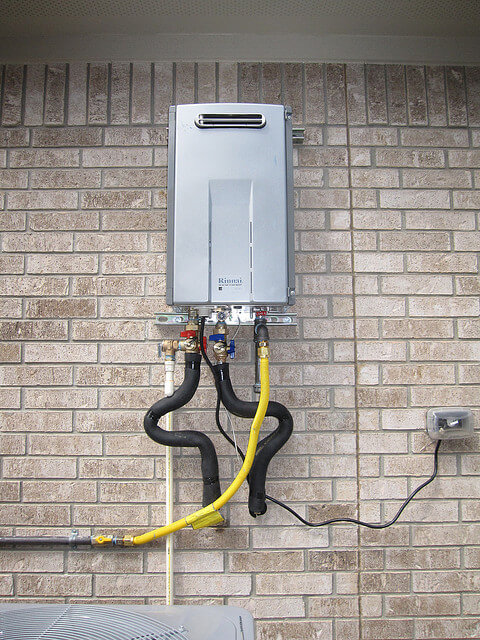
Factors Affecting Water Heater Size Selection
Choosing the proper size of water heater will help ensure you have the water you need, when you need it, and avoid the frustration of being unable to run more than one appliance at a time. You will want to look at the factors that directly affect the size, such as:
- Your household size. The size of your household determines how much water you will likely use. Many contractors will base this on the number of bedrooms in your home.
- Your pattern of water usage. If you tend to run more than one appliance or faucet at a time, you might be better served with a tank water heater or a tankless water heater that is rated for a much higher GPM than your home would typically use based on size.
- The climate you’re in. Depending upon how cold it gets where you live, your water heater might use much more energy. Look for one that is rated and recommended for your area of the country.
- Energy-efficiency. It pays to include energy-efficient options to keep your costs low over time. Look at the Energy Star guide for each water heater you consider to help you choose the most cost-efficient and energy-efficient system for you.
According to the U.S. Department of Energy, here’s a quick way to determine the size of a new water heater:
- List the appliances in your home that use hot water.
- Add up the flow rates. You can usually find this on the manufacturer’s website. (If you don’t know the actual gallons per minute, estimate it by holding a bucket underneath the faucet, opening up the tap, and letting it run for exactly one minute. The number of gallons you have in that bucket is the flow rate.)
- Add up the flow rates for appliances you might use at the same time. For instance, combine the flow rate for the shower and the washer if you like to hop in the shower after starting a load of laundry.
- Determine the temperature rise. In most cases, you will want to have water at about 120 degrees Fahrenheit. Hold a thermometer under a running faucet of cold water to be sure, but otherwise, assume that the water is typically 50 degrees Fahrenheit. That means you will need a temperature rise of 70 degrees to get all the hot water you need.
Once you have the flow rate and the temperature rise, you can begin comparing water heaters.
When it comes to tank water heaters, sizing them might be even simpler: it comes down to household size. The smallest water tank will work for two people, at 30 gallons or so. A good rule of thumb is to add an additional 10 gallons of water per person above that.
You must also consider the “first hour rating” for a tank water heater. That means how much hot water the tank can produce in a single hour. This helps you figure out how efficient the model is and what it can handle during peak usage.
Peak usage is what you might use during the busiest part of the day for your home; for many, this is the hour or two before bedtime, when you’re running the dishwasher or laundry, and everyone is getting showers. Here’s what a typical household uses:
- 30 gallons for running the washing machine
- 20 gallons per person per shower
- 14 gallons for running the dishwasher
- 6 gallons per person for washing hair
- 6 gallons for washing dishes by hand
- 3 gallons for shaving
- 2 gallons per person for washing hands
If you have an 80-gallon water heater that has a first hour rating (FHR) of 70 gallons, that means that even though the tank holds 80 gallons, the water heater can only pump out 70 gallons of hot water for that single hour. Knowing how this number works, and how much water you actually use, allows you to purchase accordingly.
Benefits of Choosing the Right Water Heater Size
The right sized water heater will bring years of comfort, while the wrong size will bring years of frustration. Choosing the right size also means choosing the energy efficiency features you want to realize cost savings down the road.
This guide can get you started; but if you still have trouble with choosing the proper size of water heater, talk to a contractor who can walk you through the variety of factors you must consider before settling on the type and model of water heater you need.
Compare top-rated plumbing pros in your area.
Read real homeowner reviews, explore qualifications, and view promotions. Modernize makes it easy to browse professionals and find one that will be perfect for your project.
